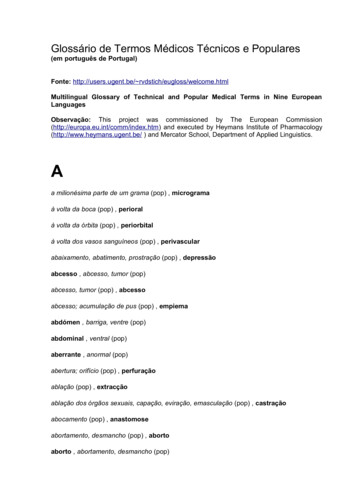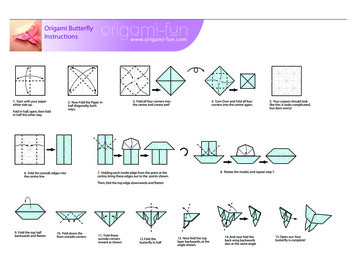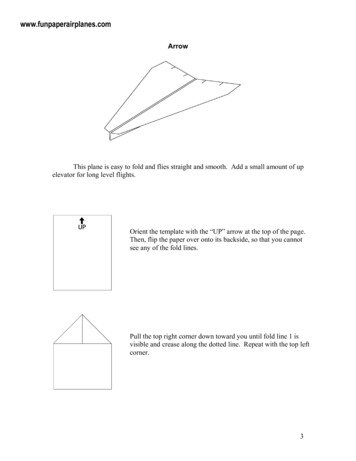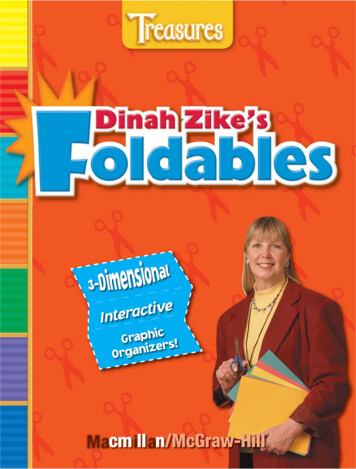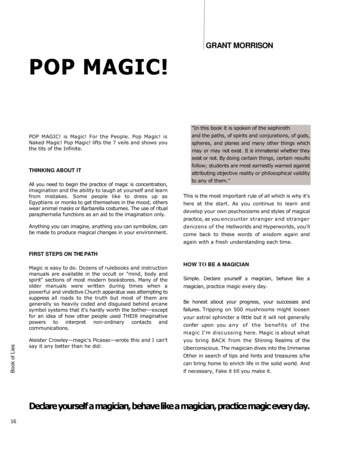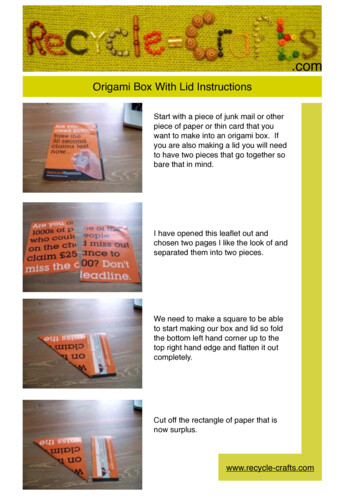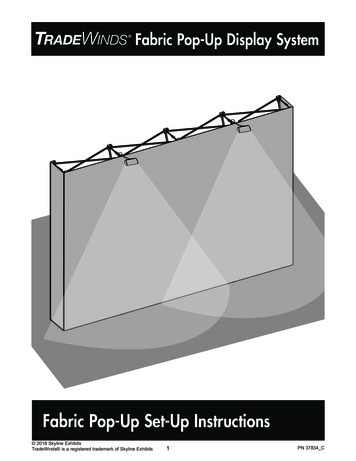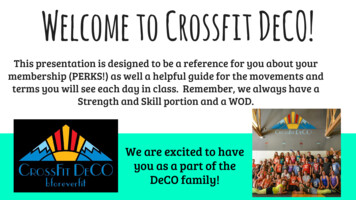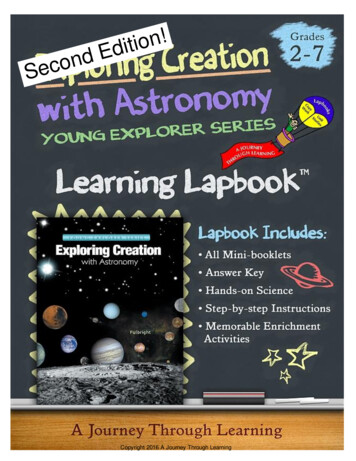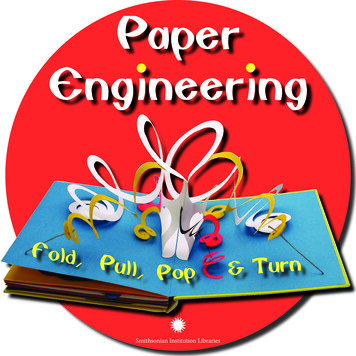
Transcription
.PaperEngineeringFold,Pull, PopSmithsonian Institution Libraries& Turn
Paper Engineering: Fold, Pull, Pop & TurnJune 2010—October 2011The Smithsonian Libraries Exhibition Gallery, National Museum of American HistoryWashington, DCwww.sil.si.eduAcknowledgmentsCuratorStephen Van Dyk, Cooper-Hewitt, National Design Museum LibraryWith assistance fromElizabeth Broman, Cooper-Hewitt, National Design Museum LibraryEllen G. K. RubinAnn Montanaro, Director, The Movable Book SocietyExhibition design, editing, and productionOffice of Exhibits Central, Smithsonian InstitutionExhibition brochure designElizabeth PerialeDedicated to Pam Stiles (1935-2005) and Waldo J. Hunt (1920-2009)who loved pop-up and movable books2
Financial SupportP. J. BradenBob and Judy Snyder and ProQuestGus and Deanne MillerAlan and Jo Priestand alsoCandlewick PressThe Gladys Krieble Delmas FoundationThe Buster FoundationThe “pop-up” PinocchioIllustrations and paper engineering by Harold LentzNew York: Blue Ribbon Books, 1933Donna GoldbergMargery and Edgar MasinterOCLCFran SmythThe Spencer Baird Annual Giving Fundand additional support fromChuck FischerBruce FosterPrinting of this brochure has been madepossible by the generosity of The Gladys KriebleDelmas FoundationCover Image: One red dot, David A. Carter, NewYork: Little Simon, 2004, Gift of Sue Ellen Appleman3
Pop-up and movable books have been delighting and engaging readers and non-readers,young and old alike, for nearly 800 years. Using inventive ways to fold paper and create movement, pop-up artists and paper engineers transform the printed page from two-dimensionalforms to three-dimensional experiences.Movables have mechanisms such as flaps, pull tabs, and wheels (volvelles) that cause movementon the page surface. Pop-ups employ various folding devices that cause figures to lift, pop up,rise and unfold, or unfold and extend when a page is opened. Despite changes in technologies,materials, and mechanisms, contemporary books, like their predecessors, are still assembledby hand and share some of the sameconstruction principles. And althoughwe may associate pop-ups and movable books with children, adults werethe original audience for what wasanything but child’s play.Paper Engineering: Fold, Pull,Pop & Turn presents more than 50examples of action-packed constructions and inspired works of art spanning 500 years.Moderne technik [Modern technology]Hans Blucher (1867-1927)Leipzig and Vienna: Bibliographisches Institut, 19124We hope exhibition visitors will experience these rarely seen treasures astheir creators intended—as remarkable works that calculate, educate,entertain, and amaze.
Moving from a static printed page to a three-dimensional mechanical book changes the dynamicbetween reader, words, and illustrations. The relationship becomes more interactive, moretactile, and, well, more dynamic. We depend on our senses to absorb and process information.Introducing the sense of touch to the mix, not to mention the element of surprise, expandswhat is primarily a visual experience. Adding movement contributes yet another way for readersand non-readers to learn and enjoy. Hands-on and kinetic, movable and pop-up books combinehands and eyes, action and reaction, discovery and wonder.Useful ToolsThe story of movable and pop-upconstruction begins within the wallsof a medieval monastery. The earliestbooks with movable parts recordedand communicated informationand also calculated data. Illustratedvolvelles or wheels were superimposed on the surface of a page,turning to align data to calculate theposition of the stars, church calendar,astrological signs, and the like. It isthought that the Benedictine monkMatthew Paris employed volvelles todetermine ecclesiastical dates as earlyas the 13th century, as did the Catalanmystic and poet Ramon Llull shortlythereafter to explain his theory ofspirituality and truth.The elements of geometrie . . .London: J.Daye, 15705
The invention and expanded use of movable press type, which began in the 1450s, coupledwith the growth of scientific knowledge published in the centuries that followed, resulted in thecreation of some of the most magnificent volvelles of all time. Among these, with beautifullyembellished wheels to calculate astrological and astronomical data, are Peter Apian’s Astronomicum caesareum (1540), Johann Schöner’s Opera mathematica (1550), and Leonhard Thurneysser’s Dess menchen circkel und lauff (1575-1583).In more modern times, wheels, placed within texts or as stand-alone objects, have been used tocount calories, match paint colors, identify bird species, score contract bridge, and present funfacts about American presidents.Enhancing Discoveryand LearningHow Better to ExplainAstronomicum caesareum [The emperor’s astronomy]Peter ApianIngolstadt, Germany, 1540On loan from Mr. and Mrs. Robert Gordon and the AdlerPlanetarium6From the 16th century onward, thepublishing of illustrated works grewrapidly. Advances in printing madebooks more accessible, and scholars demanded up-to-date recordedknowledge. Movable and pop-upbooks were used to demonstratevisually complex systems, particularlyrelating to medicine, mathematics,and technology. How better to explainthe intricate layering and position oforgans in the human body than bycreating a series of hinged flaps that
when opened reveal, for example, the chest cavity, as in David Pelham’s The human body (1983),or the multiple valves and muscles of the heart in René Descartes’ De homine [On Man] (1662).To illustrate the theorems and proofs of the Greek mathematician Euclid, three-dimensionalcubes, squares, and triangles rise from the page in The Elements of geometrie . . . (1570) [page5]. The complex parts of cars, steam-powered locomotives, ships, and other machines seen inModerne technik (1912) [page 4] are revealed and explained layer by detailed layer. Ron Van derMeer’s Inside the personal computer (1984) [page 20] provides a basic introduction to the PC,with a three-dimensional prototype that pops up off the page. And in Observations on the theoryand practice of landscape gardening(1803), English landscape designer SirHumphry Repton cleverly uses flaps tocreate “before” and “after” views thathelp prospective clients visualize thetransformation of their gardens.Teaching the BasicsMovable and pop-up books teachin clever ways, making the learningexperience more effective, interactive,and memorable. In late-18th-centuryEngland and America, an educatedmiddle-class population emergedfrom the Industrial Revolution. Theyrecognized the importance of childhood and had disposable incometo purchase books to educate theirDe homine [On man]René DescartesLeiden, Netherlands: Petrus Leffen & Franciscus Moyardus, 16627
sons and daughters. As a result, publishers developed books specifically geared to teach religionand manners, picture books that could be read aloud to children, illustrated arithmetic and ABCprimers, as well as stories for pure entertainment.London bookseller Robert Sayer created some of the earliest movables in the 1760s. Called“metamorphoses,” “turned-ups,” or “harlequinades,” they consisted of a series of flaps thatwhen lifted revealed an illustrated moral tale featuring a harlequin figure. In the 1820s, Englishminiature painter William Grimaldi with his son Stacey developed a series of flap books to teachetiquette. In his A suit of armour for youth (1824), about the virtues of being a gentleman, theanswers to riddles and popular sayA suit of armour for youthings appear when the flap is raised.Text by Stacey GrimaldiMovable and pop-up versions ofLondon, 1824.books that offer instruction on religionand cultural traditions remain popular.M. Coerezza’s Catechetical scenes: thelaw of love (1960) and Singer’s Thechildren’s Haggadah (1933) colorfullyand dramatically relate Bible stories.Learning through discovery injectssome fun into the three “Rs” aschildren uncover letters in RobertCrowther’s The most amazing hideand seek alphabet book (1977), or areintroduced to counting numbers inRenée Jablow’s Richard Scarry’s popup numbers (1996). Movable and popup books offer enticements to learn8
when they present a chance to interact by pulling tabs, turning wheels, and becoming part of theaction. For young readers, visuals can easily illustrate abstract concepts such as the oppositesof night and day, summer and winter. Contrasting images are revealed when a tab is pulled inDean’s new book of dissolving views (1860). Following a story read aloud while illustrations moveand lift off the page makes learning enjoyable and interactive. The nutcracker: a pop-up (1992),with paper engineering by Paul Wilgress, and the pop-up version of Eric Carle’s The honeybeeand the robber (1981) incorporate movable and pop-up mechanisms within the narrative.Visualizing the World Around UsMovable and pop-up books also helpus document, explore, and experiencethe wonders of our built and naturalenvironment. In paper engineerIb Penick’s Those fabulous flyingmachines (1985) [page 19] intricatelydrawn and constructed pop-upimages of aircraft seem to hover overthe page. In Vic Duppa-Whyte’s Thespace shuttle action book (1983),we can visualize the structure anddetailed parts of each vessel. Thenatural world comes alive when alarger-than-life, yet anatomicallyprecise image of a bee unfolds to360 degrees in David Hawcock’s Bee(1994). Readers encounter the stagesDean’s new book of dissolving viewsLondon: Dean & Son, 1860Gift of Margery Masinter9
of development of dinosaurs in the National Geographic Society’s action-packed Creatures oflong ago: dinosaurs (1988); experience the color, movement, and depth of the jungle in Amazingmonkeys (1985); and explore the sights and sounds of birds in their natural habitats in Birdscapes(2008).The early accordion book Thames tunnel (1843), recent pop-up surveys of the works of architects Frank Lloyd Wright (2002) and Frank Gehry (2007), and Keith Moseley’s La maison victorienne . . . (1999) all document the dynamic forms associated with buildings, monuments, andbridges. Other movables and pop-ups, such as Peter and Wendy see the New York World’s Fair(1963), commemorate historic events,while Pat Paris’ The first Noel: a holiday pop-up book (1998) and otherscelebrate seasonal festivities.Neue lebende bilder: ein ziehbilderbuch [New living pictures:a pull-picture-book]Illustrations and paper engineering by Lothar MeggendorferMunich: Verlag von Braun & Schneider, ca. 188010Movable and pop-up books providenew perspectives and enhance ourexperience of everyday activities andsurroundings. Munich artist LotharMeggendorfer was the creator ofearly complex pull-tab mechanismsthat caused multiple movementswithin one scene. In his Neue lebendebilder (1880), a butcher chops meat,a girl draws water from a well, a manteaches his dog a new trick, and twowomen wash clothes after pull-tabsinitiate the action. Meggendorfer alsocreated colorful stage-like panoramas
in Im stadtpark [The city park] (1887) and illustrated his books with whimsical yet familiar characters that greatly appealed to young readers. We get a bird’s-eye view of the inside of a 1950sservice station when the carousel book Garage (1950) is fully unfolded. As the central page ofBruce Foster’s Wow!: The pop-up book of sports (2009) is opened, we’re suddenly at center courtwith the net lifting off the surface and a tennis ball zooming directly at us.Stories that feature children relating to the world are the focus of many movable and pop-upbooks. Children play together in Raphael Tuck & Sons’ Jolly companions (1896) and participate inthe adventures of the Jolly Jump-Ups family, a series of stage-set pop-ups created by GeraldineClyne (1930s-1960s). Ernest Nister,The model menagerie: with natural history storiesa Nuremberg publisher and innovaL.L. Weedon, Evelyn Fletcher, and Ernest Nistertor of pop-up and movable mechaNew York: E.P. Dutton, ca. 1895nisms, regularly features well-dressedGift of Dr. Daniel J. MasonVictorian children in stories like hisCircling surprises (1901), a revolvingwheel slat book. A visit to the zoobecomes an exciting adventure inNister’s The model menagerie (1895),when caged animals magically lift intothree-dimensional forms as each pageis turned. Children enjoy a trip to thecircus in paper engineer Julian Wehr’sAnimated circus book (1943), in whichhis pull-tab system allows circus animals and performers to move across apage in all directions.11
For the Fun of ItNovelty Books / Toys and GamesMost movable and pop-up books were created to entertain, and many of the great innovatorsdesigned books that still amuse us. In the late 18th century, German engraver MartinEngelbrecht created illustrated and intricately cut paper cards that, when placed behind eachother at intervals, created tunnel-like works with dramatic perspective views. His peep-showswere popular parlor amusements and inspired tunnel books in the centuries that followed. Inthe 19th century, advances in printing and paper production helped spur the growth ofaffordable and accessible printednovelties, board games, toys, juvenilestory books, and movables andpop-ups.The interactive elements of movablesand pop-ups are much like playing agame. The amusement and delightof discovery and the ability to lift andpull mechanisms are all opportunitiesfor the reader to participate. Lifting aflap or pulling a tab in Bennett Cerf’sPop-up riddles (1967) or Tor Lokvig’sWhat do you get? (1960s) providesanswers to riddles and questions.Garden sceneMartin EngelbrechtAugsburg, Germany, ca. 174012
You can discover all five senses in Tony Sarg’s Surprise book (1941), and find the hidden numbersin Paul Zelinsky’s Knick-knack paddywack! (2002) nursery rhyme book.Fairy TalesA longstanding tradition and popular theme of movables and pop-ups is the re-telling of fairytales and fables. As early as the 1850s, London publisher Dean & Son, considered one of thepioneering innovators of books with movable parts such as the pull tab and the dissolving image,developed movable editions of Aladdin, Cinderella, and Little Red Riding Hood. In Dean’s Cinderella, or, The little glass slipper (1850), die-cut images lift from the surface of the page when aribbon is pulled.The McLoughlin Brothers, a New Yorkbased publisher of board games andsome of America’s earliest pop-upbooks, retell the story of Aladdin. Intheir pantomime book, Aladdin, or,The wonderful lamp (1880) [page 22],movable characters appear in a stagelike setting. From 1932-1935, The BlueRibbon Publishing Company of NewYork produced a series of colorful,large-type fairy tale pop-up booksunder the direction of paper engineerHarold B. Lentz. These included The“pop-up” Mother Goose, Jack the giant killer, Puss in Boots, and SleepingBeauty. The Pop-up Pinocchio (1932)Cinderella, or, The little glass slipperLondon: Dean & Son, ca. 1850Gift of Dr. Daniel J. Mason13
[page 3], an abbreviated version of the traditional Italian folk story, featured several distinctivev-fold and box and cylinder constructions: one with Pinocchio reading, another of his house, andyet another of a large whale.Mario Zampini, an Italian illustrator and stage designer, uses a series of theatrical sets in a carousel book to recreate the story of Ali Baba and the 40 thieves [Ali Baba e i 40 ladroni] (1950). Newinterpretations of fairy tales and traditional folk stories remain popular and continue to inspirepaper engineers and pop-up artists today.Adventure and Fantasy StoriesAli Baba e i 40 ladroni [Ali Baba and the 40 thieves]Mario Zampini and Raimondo CenturioneMilan: Hoepli editore, ca. 1950Gift of Roma and David Korris14Adventure and fantasy stories for children were first published in the 19thcentury. Many of the most popular ofthese were issued in several subsequent editions and later in pop-upand/or movable versions—mostnotably Peter Rabbit, Winnie-thePooh, and Charles Kingsley’s 1920novel Water-babies. S. Louis Giraud,publications manager for London’sDaily Express, in collaboration withinventor Theodore Brown, created atrue “pop-up” book that automaticallyunfolds to become a three-dimensional free-standing figure viewable fromall sides.
These new pop-up constructions appeared in Giraud’s adventure story Animal life in fact, fancyand fun (1930).In the 1950s-1960s, Vojtěch Kubašta, an Austrian-born paper engineer and illustrator working inCzechoslovakia, created a series of pop-up adventure and fantasy stories combining bold folk artstyle imagery, distinctive colors, and innovative cut and folded paper styles. Some of his largescale constructions of this period include Marco Polo (1962), The tournament (1950s), and Rickythe Rabbit (1961). Later and contemporary pop-up fantasy and adventure books include JamesRoger Diaz’s Alice’s adventures in Wonderland (1980), Jan Pieńkowski’s Robot (1981), RobertSabuda’s The wonderful wizard of OzAnimal life in fact, fancy, and fun(2000), and Sam Ita’s Moby Dick: aEdited and produced by S. Louis Giraudpop-up book (2007).Movable and pop-up books have alsoreflected the influence of popularculture and the mass media. In the1930s, The Blue Ribbon PublishingCompany and Pleasure Booksintroduced a series of small, colorful,comics-inspired pop-up books thatincluded Dick Tracy, capture of BorisArson (1935) and Terry and thePirates in ”Shipwrecked” (1935) [page16]. Later pop-ups featured charactersfrom television series such asHopalong Cassidy lends a helping hand(1950) and Sesame Street (1970s-England: Daily Sketch & Sunday Graphic, ca. 1930Gift of Dr. Daniel J. Mason15
1980s). More recently, our fascination with outer space is interpreted by Chuck Murphy’s StarTrek-themed These are the voyages (1996) and Matthew Reinhart’s action-packed Star Wars: apop-up guide to the galaxy (2007). Pop-ups based on Disney’s animated films remain perennialfavorites.Fantastic FormsFor centuries, designers and paper engineers have manipulated and folded paper in innovativeand interesting ways to create sculptural forms within pop-ups. When unfolded, panoramas,peep-shows, and carousels are transformed into rectangular tunnels, box, and circular papersculptures. In other books, sculpTerry and the Pirates in “Shipwrecked”tural forms such as cylinders, globes,Milton Caniffsquares, and the like pop up from theChicago: Pleasure Books, 1935Gift of Dr. Daniel J. Masonsurface when a page is turned.In the 1960s, American businessmanWaldo Hunt, inspired by the sculptural cut-paper forms and illustrationsof Vojtěch Kubašta, was instrumental in reviving the manufacture ofpop-up and movable books. Huntfounded Intervisual Communications in the 1970s to produce pop-upbooks exclusively. He promoted paperengineers such as Jan Pieńkowski, TorLokvig, David Pelham, Marcin Stajewski, James Roger Diaz, Keith Moseley,John Strejan, Ib Penick, David Carter,16
and Ron Van der Meer, among others. They created hundreds of popular movables and pop-ups,many with new and innovative construction forms, during the 1970s-1980s. These paper engineers, along with others working later into the 1990s and beyond, benefited from advancementsin computer-aided design, laser printers, and cutting devices that made the use of intricate foldsand complex paper parts possible for mass market production.Contemporary paper engineers employ diverse and complex mechanisms on each page, adding greatly to their books’ interactive qualities. In the beginning (2008) by Fischer/Foster andMega-beasts (2007) by Sabuda/Reinhart are wonderful examples. Designers challenge the limitsof the three-dimensional form byMega-beastscreating intricate constructions thatRobert Sabuda and Matthew Reinhartdramatically emerge from the pageCambridge, MA: Candlewick Press, 2007surface, such as Bible stories from theOld Testament . . . (1991) by ChristosKondeatis.Others cleverly conceal pull mechanisms over multiple images to createmovement—Gallop! (2007) by RufusSeder—or innovative cut-paper foldsto reveal pop-up figures—Numbers(2000) by Kees Moerbeek.And yet, in still other pop-ups, thesimple, dynamic quality of the cutpaper forms and mechanisms dominate, enhancing the appearance ofthe book as a sculptural work of art:17
Marion Bataille’s ABC-3D (2008) [page 17] and David Carter’s One red dot (2004) [cover].Today’s imaginative paper engineers continue to explore and to innovate new ways to fold paper,devise complex pull tabs that create movement, design intricate three-dimensional pop-upforms, and use cut paper, string, and other mechanisms to make figures magically twist and turn.The possibilities seem endless. Each year hundreds of action-packed, beautifully crafted workspop up to inspire, awe, educate, and heighten our love and enjoyment of books.Whether early or contemporary, movables and pop-ups dramatically offer children and adultsthe opportunity to discover and experience the joy of books in delightful and remarkable ways.ABC–3DMarion BatailleNew York: Roaring Brook Press, 2008Gift of Elizabeth Broman18
What Makes Pop-ups Pop?The answer lies in a variety of methods of cutting and folding, and in mechanisms hidden behind and underneath thepage. The construction methods are endless, but they can be divided into four categories: movable parts that lie flat,images that pop up, books that fold, and fantastic forms that use multiple mechanisms.Movables: Elements lie flat on the page—but they don’t lie still. These books fall into a few basic construction types:volvelles or wheels, flap books, and pull tabs.Pop-ups: Three-dimensional figures spring to life in pop-up books, rising from the surface of the page. Four basicconstruction techniques are used in creating pop-ups: stage set, v-fold, box and cylinder, and floating layers. In each ofthese methods, cleverly folded paper cut-outs unfold when the book is opened and a page is turned.Folding mechanisms: Some books aredesigned to open like an accordion, or tofan out and form a circle. Books that unfoldcan take a variety of forms, which are calledleporellos, carousels, and tunnel books orpeep-shows.Multiple constructions: Contemporary paperengineers don’t confine themselves to asingle method. By exploring combinations ofconstruction techniques, they find new waysto amuse, teach, and surprise us. Paper is nolonger the only material used. Plastic, string,mirrors, and sticks are now part of the pop-upmix.Those fabulous flying machinesText by Seymour ReitIllustrations by Randy Weidner and Frank OssmanConcept and paper engineering by Ib PenickNew York: Macmillan, 1985Gift of Dr. Daniel J. MasonPop-up ElementsBox and cylinder: A box-like cube or roundedcylinder rises from the center of the pagespread as the book is opened.19
Carousel: In a carousel book, the covers are folded back and opened to a complete circle and secured with string,ribbon, snaps, or Velcro. This creates a series of three-dimensional dramatic scenes that tell a story or sometimespresent a set of little rooms to play in.Dissolving images and slats: An illustration changes into a completely different scene at the pull of a tab. Thedissolving effect, or transformation, is achieved by the pictures being printed on horizontal, vertical, or circularsections that slide over each other. These are sometimes also called metamorphoses.Flap or lift the flap: One of the simplest forms in a movable. When a piece of illustrated paper, attached to the basepage at a single point, is lifted, a hidden illustration, message, or movable is revealed. Harlequinades or pantomimebooks, in which each lifted flap changes the picture or reveals a new twist in the plot, are a form of flap mechanism.Flaps may be cut into the shape of the illustration.Inside the personal computerText by Sharon GallagherPaper engineering and design by Ron van der MeerNew York: Abbeville Press, 1984Gift of Dr. Daniel J. MasonFloating layers or platforms: Thismechanism is best understood whenseen from the side. Hinged multi-tierpaper supports lift an illustration offthe page, creating the illusion that it isfloating over the surface.Harlequinades and metamorphoses:A series of flaps that when lifted reveal anew picture or message. Also, a bookletwith illustrations split in the center,laterally. When the illustration is foldedup or down, or the series of flaps arelifted, a new picture or message underneath is revealed. Some 18th-centuryflap books were inspired by the theater.Often featuring the comic characterHarlequin, these were called harlequinades or pantomime books.20
Leporello: An accordion book formed of one long sheet of folded paper that stretches out in a zigzag or concertinashape. It is named after Leporello, the servant in the opera Don Giovanni, who carries such a book to record theendless list of Giovanni’s romantic conquests.Paper engineer: An artist who uses various techniques (e.g., cutting, folding, and/or gluing) to make paperillustrations move or pop up. The paper engineer may or may not also be the illustrator.Pull-tab: A sliding paper tab, ribbon, or string is pulled, pushed, and maneuvered to reveal a new image. The tabs canalso activate a pop-up. A figure goes into action when you pull or slide a tab: dancers sway, dogs sit up and beg,robots move.Stage set or multiple layers: A book becomes a theater set when it is opened to a 90-degree angle. This was one ofthe first constructions to be used for pop-up books and particularly suited to display interior scenes.Tunnel book or peep-show: A series of cutpaper panels are placed or hinged one behindthe other, creating the illusion of depth andperspective, like looking into a tunnel. Theterm “peep-show” is derived from 18th- and19th-century itinerant showmen who carriedthese mechanisms from place to place andcharged a fee for viewing.V-fold: This versatile form is what most peoplethink of when they hear the term “pop-up.”The pop-up element is attached to facingpages and unfolds from the center of the pagewhen the book is open; it collapses into itselfwhen the book is closed.The falshood of external appearancesEngland, ca. 179021
Volvelle or wheel: An illustrated paper disc or circle is attached to a page using string, paper, or grommets andrevolves around a central pivot. As the reader turns the wheel, the discs align images and information. The disc can beperforated to reveal designs underneath. The word volvelle is derived from the Latin verb, volvere, to turn.Waterfall: An embellishment of the pull-tab activated flap, several flaps open onto each other sequentially as thesingle tab is pulled in the opposite direction.Learn MorePrint ResourcesBarton, Carol. The pocket paper engineer, volume I: basic forms: how to make pop-ups step-by-step. Glen Echo, MD:Popular Kinetics Press, 2005.Aladdin, or, The wonderful lampNew York: McLoughlin Brothers, ca. 1880Gift of Ellen LimanBarton, Carol. The pocket paper engineer,volume 2: platforms and props: how tomake pop-ups step-by-step. Glen Echo,MD: Popular Kinetics Press, 2008.Carter, David, and James Diaz. Elements ofpop-up: a pop-up book for aspiring paperengineers. New York: Little Simon, 1999.DuLong, Jessica, et al. A celebration ofpop-up and movable books. New Brunswick, NJ: Movable Book Society, 2004.Haining, Peter. Movable books: anillustrated history. London: New EnglishLibrary, 1979.Hiner, Mark. Paper engineering for pop-upbooks and cards. Norfolk, England: Tarquin Publications, 1985.Montanaro, Ann R. Pop-up and movablebooks: a bibliography. Metuchen, NJ:Scarecrow Press, 1993, and Supplement1, 1991-1997. Lanham, MD: ScarecrowPress, 2000.22
Movable stationery. New Brunswick, NJ: The Movable Book Society, 1993.Weinstein, Amy. Once upon a time: illustrations from fairytales, fables, primers, pop-ups, and other children’s books.New York: Princeton Architectural Press, 2005.Yokoyama, Tadashi. The best of 3D books. Tokyo, Japan: Rikuyo-sha Pub., 1989.Online ResourcesA concise history of pop-up books by Ann montanar/p-intro.htmThe Movable Book Society:www.movablebooksociety.orgPop-up and movable books: a tour through their history by University of North Texas Rare Book and Texana /popup2/default.htmPop goes the page by University of Virginia Brenda Forman dex.htmlThe pop-up lady by Ellen Rubin:www.popuplady.comRead and comment on our Fold, Pull, Pop & Turn 3
24
Ann Montanaro, Director, The Movable Book Society. Exhibition design, editing, and production. Office of Exhibits Central, Smithsonian Institution Exhibition brochure design. Elizabeth Periale Dedicated to Pam Stiles (1935-2005) and Waldo J. Hunt (1920-2009) who loved pop-up and movable
